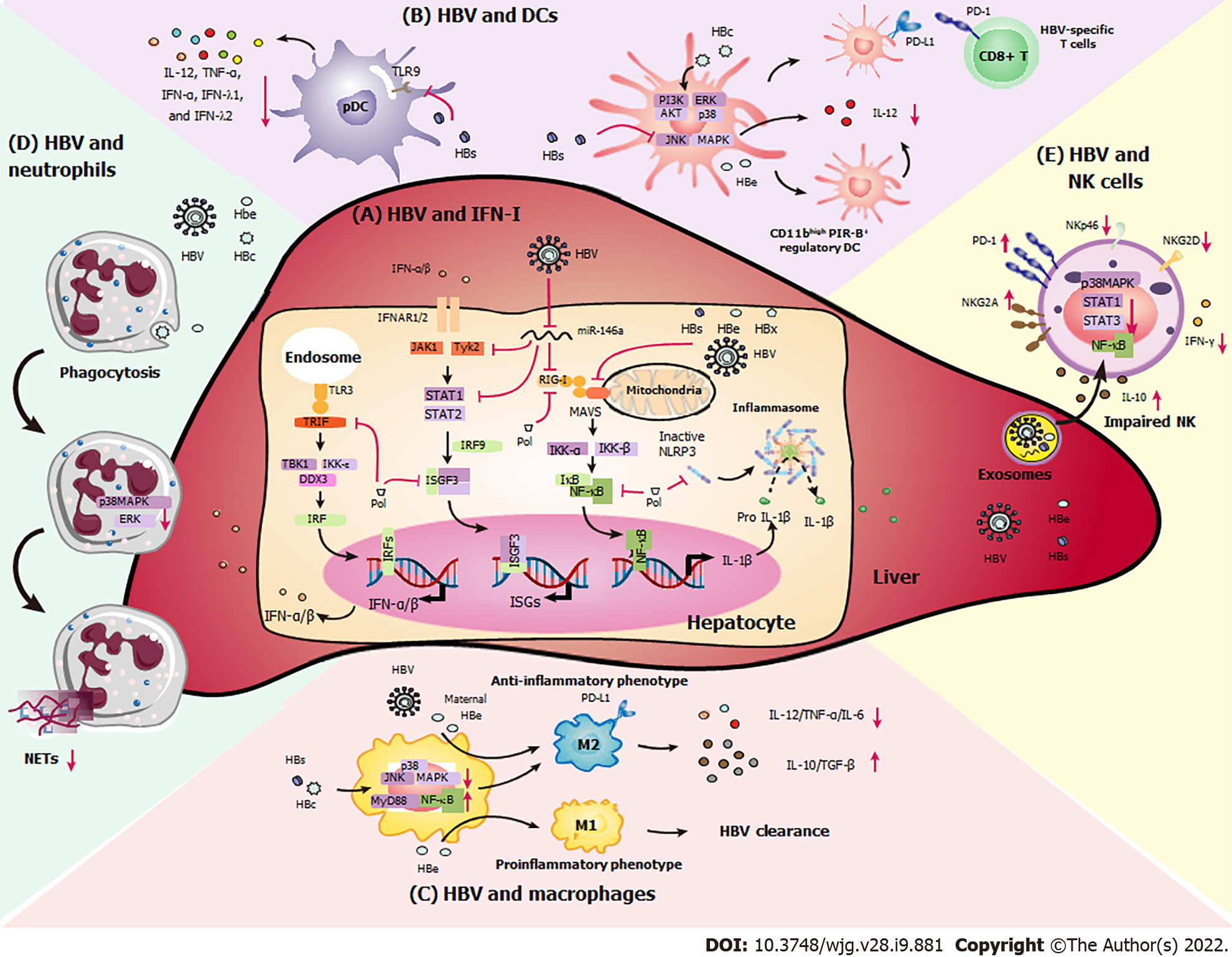Copyright
©The Author(s) 2022.
World J Gastroenterol. Mar 7, 2022; 28(9): 881-896
Published online Mar 7, 2022. doi: 10.3748/wjg.v28.i9.881
Published online Mar 7, 2022. doi: 10.3748/wjg.v28.i9.881
Figure 1 The interaction between hepatitis B virus and innate immunity.
A: Hepatitis B virus (HBV) suppression of the type I interferon (IFN-I) response. HBV infection inhibits IFN-I transcription and signal transduction and IFN-β synthesis; B: HBV affects the function of dendritic cells (DCs). HBV upregulates programmed death-ligand 1 and induces regulatory DCs that exhibit extremely low T cell-stimulatory capacity and interleukin-12 production; C: HBV affects the function of macrophages. HBV-related antigens affect macrophage polarization (M1/M2), contributing HBV clearance or HBV persistence; D: HBV affects the function of neutrophils. HBV-related antigens decrease neutrophil extracellular trap release, which facilitates HBV immune escape, replication, and persistence; E: HBV affects the function of natural killer (NK) cells. HBV-related antigens and HBV-derived exosomes dampen the Retinoic acid-inducible gene I, nuclear factor kappa B, and p38 mitogen-activated protein kinase signaling pathways, resulting in the functional suppression of NK cells during chronic hepatitis B infection. DCs: Dendritic cells; DDX3: DEAD-box RNA helicase 3; ERK: Extracellular-regulated kinase; HBc: Hepatitis B core antigen; HBe: Hepatitis B envelope antigen; HBs: Hepatitis B surface antigen; HBx: HBV X protein; HBV: Hepatitis B virus; IFN-α: Interferon-α; IFN-β: Interferon-β; IFN-γ: Interferon-γ; IFN-I: Type I interferon; IFNAR: Interferon-α receptor; IKK-ε: IB kinase ε; IL-1β: Interleukin-1β; IL-6: Interleukin-6; IL-10: Interleukin-10; IL-12: Interleukin-12; IRF3: Interferon regulatory factor 3; ISGs: Interferon-stimulated genes; ISGF3: Interferon-stimulated gene factor 3; JAK: Janus kinase; JNK: c-Jun N-terminal kinase; M1: M1-like macrophages; M2: M2-like macrophages; MAPK: Mitogen-activated protein kinase; MAVS: Mitochondrial antiviral-signaling protein; miR-146a: microRNA-146a; MyD88: Myeloid differentiation primary response gene 88; NET: Neutrophil extracellular trap; NK: Natural killer; NKG2D: Natural killer group 2 member D; NKG2A: Natural killer group 2 member A; NF-B: Nuclear factor kappa B; PD-1: Programmed cell death protein 1; pDCs: Plasmacytoid DCs; PD-L1: Programmed death-ligand 1; PI3K: Phosphatidylinositol 3-kinase; Pol: Hepatitis B virus polymerase; Pro-IL-1β: IL-1β precursor; RIG-I: Retinoic acid-inducible gene I; STAT1: Signal transducer and activator of transcription 1; STAT2: Signal transducer and activator of transcription 2; TBK1: TANK-binding kinase 1; TGF-β: Transforming growth factor-β; TLR2: Toll-like receptor 2; TLR3: Toll-like receptor 3; TLR9: Toll-like receptor 9; TNF-α: Tumor necrosis factor-α; TRIF: Toll/IL-1 receptor domain-containing adaptor inducing IFN-β; Tyk2: Tyrosine kinase 2.
- Citation: Zhao HJ, Hu YF, Han QJ, Zhang J. Innate and adaptive immune escape mechanisms of hepatitis B virus. World J Gastroenterol 2022; 28(9): 881-896
- URL: https://www.wjgnet.com/1007-9327/full/v28/i9/881.htm
- DOI: https://dx.doi.org/10.3748/wjg.v28.i9.881









